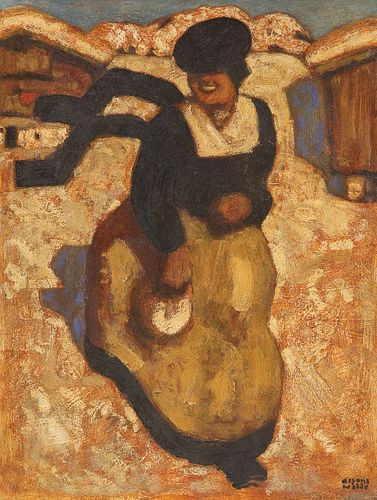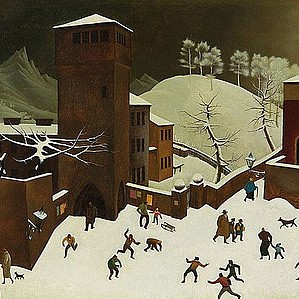ALFONS WALDE (Oberndorf 1891 - 1959 Kitzbühel) Peasant Woman, around 1924
Lot 207
Estimate:
EUR€50,000 - EUR€150,000
$54,347.83 - $163,043.48
Absentee vs Live bid
Two ways to bid:
- Leave a max absentee bid and the platform will bid on your behalf up to your maximum bid during the live auction.
- Bid live during the auction and your bids will be submitted real-time to the auctioneer.
Bid Increments
| Price | Bid Increment |
|---|---|
| EUR€0 | EUR€10 |
| EUR€100 | EUR€50 |
| EUR€700 | EUR€100 |
| EUR€1,000 | EUR€200 |
| EUR€3,000 | EUR€300 |
| EUR€3,600 | EUR€400 |
| EUR€4,000 | EUR€500 |
| EUR€7,000 | EUR€1,000 |
| EUR€16,000 | EUR€2,000 |
| EUR€30,000 | EUR€3,000 |
| EUR€36,000 | EUR€4,000 |
| EUR€40,000 | EUR€5,000 |
About Auction
By Widder Auctions
May 19, 2022
Set Reminder
2022-05-19 11:00:00
2022-05-19 11:00:00
America/New_York
Bidsquare
Bidsquare : Masterpieces
https://www.bidsquare.com/auctions/widder-auctions/masterpieces-9287
Masterpieces of classical modernism by Austrian and international artists coming up for auction in Vienna on May 19th Widder Auctions office@widderauktionen.com
Masterpieces of classical modernism by Austrian and international artists coming up for auction in Vienna on May 19th Widder Auctions office@widderauktionen.com
- Lot Description
ALFONS WALDE*
(Oberndorf 1891 - 1959 Kitzbühel)
Peasant Woman, around 1924
oil and tempera/cardboard, 31,5 x 23,7 cm
signed Alfons Walde
the work is included in the catalog raisonné of Alfons Walde with the number D-FI-345
certificate of authenticity from Michael Berger is included
Provenance: purchased directly from the artist, private property France, auction house Rossini 2021, private collection Austria
ESTIMATE °€ 50.000 - 150.000
Austrian painter and architect of the 20th century. Important representative of Tyrolean modernism. Early influences of Ferdinand Hodler, Gustav Klimt, Egon Schiele and Albin Egger-Lienz. Came from Tyrol, studied at the Technical University in Vienna. Served in World War I from 1914 to 1918, returned to Kitzbühel in 1918. Friendship with labor poet Alfons Petzold. Founded the art publishing house Alfons Walde in 1923, selling postcards and art prints of his most popular paintings there. Built his Berghaus on the Hahnenkamm in 1929 as a social meeting place, oversaw remodeling of Mittersill Castle. Shaped tourism in Tyrol, designed logo of Garms for Kitzbühel in 1933, winter sports advertising posters and the red ski clothing of ski instructors. He dealt with the tradition of his homeland. Created mountain landscapes, snow-covered winter landscapes with rural architecture, mountain farms and depictions of everyday Tyrolean and peasant life in simplified drawing and strong, impasto coloring.
The decision whether he should go to Vienna after returning from the front or to Kitzbühel forever moved Alfons Walde, the great pioneer of modernism in Tyrol, only for a short time. In the summer semester of 1917/18 he enrolled at the Technical University in Vienna. Later, around 1925, he noted: "At that time I had studied technology a lot [...] architecture [...] it is better than studying painting [...] a precise science [...] descriptive geometry ... perspective [...]." But Walde found himself no longer cope in the world of the big city. He had never been a fan of the big city; it always pushed him out into his usual living space. In the pre-war period he only spent the time necessary for his studies in Vienna. Even the post-war period in Vienna, which was rich in motifs for a sensitive artist, had not been able to captivate him. It was only in his familiar Tyrolean surroundings that his pent-up artistic sensitivity broke through.At first it was the motifs that had been worked out before 1914, but they now called for a more generous formulation: The "Funfair", in the original version from 1913, was redesigned in a broader, denser representation from 1919 in the overall picture and in the details. It was precisely in these years after 1918 that he painted large-format motifs that, from today's perspective, are among the main works of Walde's oeuvre. Impressive works such as “Fasnacht” or “Stadt im Tau Schnee” were created. The expressionistic sound effect of the colors and the composition, which grew during the war years, appears fulfilled in the Kitzbühel genre scenes of the post-war years. Parallel to the large formats, Walde painted insights into everyday scenes in the village on small cardboard pictures: in front of the house, "meeting", "going to church", farmers at "Hoangart", "procession". The fine, often brilliant coloring of the early period has given way here to the denser local tone. Walde's vocabulary of motifs had changed only slightly, but he was able to increase the expressiveness to a great extent in a form-reduced expressiveness. Heinrich Hammer wrote about Walde in 1921: “Every effort is made to make the outline as descriptive as possible [...] it is always small, harmless situations that allow a few figures to be placed in the picture with moving outlines and in an attractive arrangement . Of course, the color is also an essential element: nothing but rough, unmodulated models, so that the picture is as natural in its effects as these people are in life.” Walde painted several versions of this cheerfully laughing young farmer's wife from Kitzbühel, who strides across the diagonal of the picture so dynamically that the ribbons of her little black hat boldly wave behind her head. The present one can probably be considered the prettiest and smartest. A kind of bag or perhaps a palm pretzel dangles merrily from the young woman's right hand; In this variant, the snow-covered Wilder Kaiser rises up against a blue sky in the background.
PLEASE NOTE:
The purchase price consists of the highest bid plus the buyer's premium, sales tax and, if applicable, the fee of artists resale rights. In the case of normal taxation (marked ° in the catalog), a premium of 24% is added to the highest bid. The mandatory sales tax of 13% is added to the sum of the highest bid and the buyer's premium. The buyer's premium amounts to 28% in case of differential taxation. The sales tax is included in the differential taxation. - Shipping Info
-
Shipping
We will send you the invoice shortly after the auction. As soon as we have recieved the amount, the art can be picked up at Johannesgasse 9-13, 1010 Vienna. Please note that the buyer is responsible for pick-up and shipping of the lot.
Should you wish to ship your items, please contact: Mailboxes Email: oper@mbe-co.at Tel: 01 5128855
Please note that storage fees may apply, should the pieces not be picked up within 14 days after invoicing for domestic and 28 days for international transportation.
Our team will be happy to assist you with any further information at office@widderauktionen.com or at 0043 676 555 66 10.
-
- Buyer's Premium



 EUR
EUR CAD
CAD AUD
AUD GBP
GBP MXN
MXN HKD
HKD CNY
CNY MYR
MYR SEK
SEK SGD
SGD CHF
CHF THB
THB














